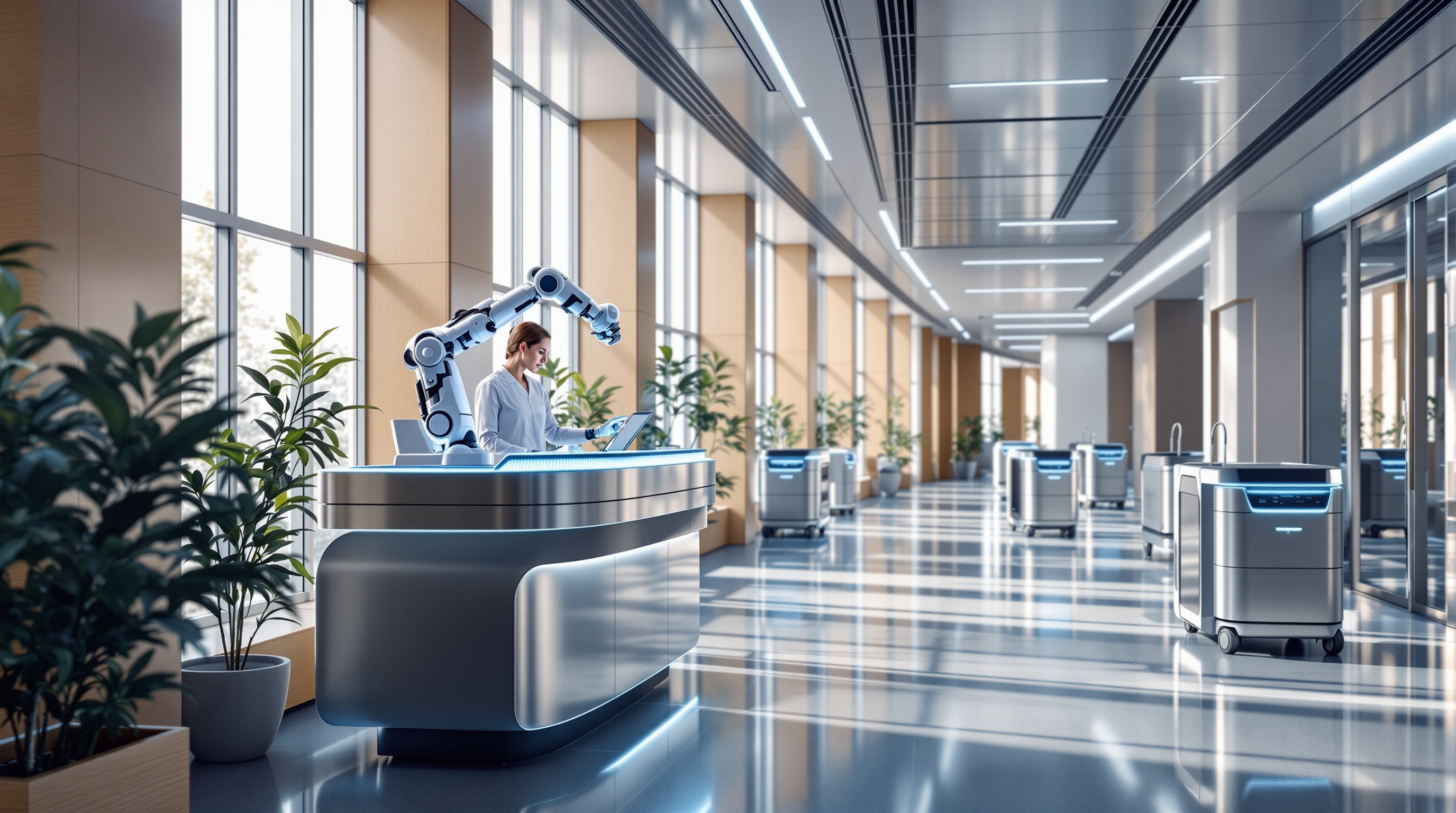Robotic Process Automation in Healthcare: Benefits for Skilled Nursing
Discover how robotic process automation boosts efficiency, accuracy, and patient care in skilled nursing facilities. Streamline operations with RPA today.
Quick Navigation
- 1. Introduction
- 2. Current Challenges in Robotic Process Automation Healthcare
- 3. How Sparkco AI Transforms Robotic Process Automation Healthcare
- 4. Measurable Benefits and ROI
- 5. Implementation Best Practices
- 6. Real-World Examples
- 7. The Future of Robotic Process Automation Healthcare
- 8. Conclusion & Call to Action
1. Introduction
Skilled nursing facilities (SNFs) across the country are facing unprecedented challenges, with staffing shortages and administrative burdens reaching critical levels. In fact, according to recent reports, nearly 80% of nursing homes are struggling to fill essential roles, putting immense strain on caregivers and compromising patient care quality. As the demand for post-acute and long-term care continues to climb—driven by an aging population and increasingly complex resident needs—facilities are searching for innovative solutions to operate efficiently without sacrificing the human touch.
Enter robotic process automation (RPA), a rapidly evolving technology that is transforming healthcare operations. By automating repetitive, time-consuming tasks—such as billing, admissions, scheduling, and compliance reporting—RPA empowers staff to focus on what truly matters: delivering compassionate, hands-on care. Not only does this boost efficiency and accuracy, but it also helps address staffing gaps and reduces the likelihood of burnout among healthcare professionals.
In this article, we’ll explore how RPA is revolutionizing skilled nursing facilities, from streamlining administrative workflows to supporting direct patient care. We’ll dive into real-world applications, highlight the benefits and challenges, and offer expert insights on successfully integrating automation in the unique environment of SNFs. Whether you’re a facility administrator, clinician, or healthcare IT leader, read on to discover how embracing RPA can help your organization thrive in an increasingly complex landscape.
2. Current Challenges in Robotic Process Automation Healthcare
Robotic Process Automation (RPA) is rapidly transforming administrative workflows in healthcare, automating repetitive tasks such as data entry, billing, and patient onboarding. While RPA offers significant benefits in efficiency and accuracy, its adoption is not without challenges. Healthcare facilities, particularly those balancing tight budgets and regulatory scrutiny, encounter a unique set of pain points as they implement RPA solutions.
-
1. Integration with Legacy Systems
Many healthcare organizations rely on outdated legacy systems that are not easily compatible with modern RPA tools. According to Itransition, integrating RPA with existing electronic health record (EHR) systems and other infrastructure can be complex and costly, often requiring custom solutions or middleware. This increases both implementation time and expenses. -
2. Data Security and Compliance Risks
Healthcare is a highly regulated industry, governed by legislation like HIPAA in the US. RPA bots handle vast amounts of sensitive patient data, raising concerns about data breaches and compliance violations. In a 2022 survey, 46% of healthcare IT leaders cited compliance and security as their top challenges for RPA adoption (Itransition). -
3. High Initial Investment and Uncertain ROI
While RPA can save costs in the long term, the upfront investment in licenses, integration, and staff training can be prohibitive—especially for smaller skilled nursing facilities and hospitals. A report notes that 60% of organizations struggle to justify the ROI of RPA projects due to delayed or unclear benefits (Itransition). -
4. Workforce Adaptation and Resistance
RPA implementation often requires clinical and administrative staff to adapt to new workflows and technologies. Resistance to change, fear of job displacement, and lack of digital literacy can slow adoption. According to research published in PMC, adapting the workforce is a major societal and organizational challenge as automation becomes more prevalent in nursing and care environments. -
5. Limited Scope of Automation
Current RPA solutions are best suited for rule-based, repetitive tasks. Many complex healthcare processes—such as nuanced patient assessments or multidisciplinary care planning—cannot be fully automated. This limits the impact of RPA on improving clinical outcomes and patient care. -
6. Managing Increasing Volumes of Data
The healthcare sector generates enormous amounts of data. While RPA can help manage and process this data, scalability remains a concern. As data volumes grow, ensuring that RPA systems remain efficient and responsive is a persistent operational challenge (Itransition). -
7. Maintenance and Continuous Improvement
Once deployed, RPA bots require ongoing monitoring, updates, and optimization to remain effective and compliant with evolving regulations. This adds to the ongoing operational burden for IT departments already stretched thin.
These challenges collectively impact healthcare operations by increasing the complexity of technology management, straining compliance efforts, and creating potential gaps in patient care continuity. Addressing these pain points is essential for healthcare facilities to realize the full benefits of RPA and maintain high standards of care in an increasingly digital landscape.
3. How Sparkco AI Transforms Robotic Process Automation Healthcare
Robotic process automation (RPA) is rapidly reshaping healthcare by automating repetitive administrative tasks, streamlining workflows, and empowering staff to focus on patient care. However, many healthcare organizations face significant challenges when implementing RPA, including integration with legacy systems, maintaining data security, ensuring accuracy, and managing change across teams. Sparkco AI addresses these hurdles with a robust suite of AI-driven automation solutions designed for the unique needs of healthcare providers.
-
1. Seamless Integration with Existing Systems
One of the primary challenges in healthcare RPA is integrating automation tools with diverse electronic health records (EHR), billing platforms, and legacy software. Sparkco AI offers flexible APIs and pre-built connectors, allowing rapid deployment without costly system overhauls. This ensures smooth data flow across platforms—enabling facilities to automate processes like patient scheduling, insurance verification, and claims management while maintaining continuity and compliance. -
2. Advanced Data Security and HIPAA Compliance
Protecting sensitive patient information is non-negotiable. Sparkco AI employs robust encryption, role-based permissions, and audit trails to safeguard data at every step. AI-powered monitoring detects anomalies and proactively addresses potential risks, ensuring that all automated workflows meet HIPAA and other regulatory standards. This gives providers peace of mind while eliminating bottlenecks in compliance-heavy workflows. -
3. Intelligent Error Reduction
Manual data entry and repetitive administrative work are prone to costly errors. Sparkco AI’s intelligent automation leverages machine learning to verify information, flag inconsistencies, and learn from corrections over time. By automating claim submissions, patient intake, and records management, Sparkco AI significantly reduces human error, accelerates processes, and helps organizations avoid expensive denials and rework. -
4. Streamlined Workflow Automation
Healthcare staff often juggle multiple systems and redundant tasks, contributing to burnout and inefficiency. Sparkco AI automates end-to-end workflows—such as prior authorizations, discharge planning, and billing reconciliation—by orchestrating tasks across departments. This empowers teams to focus on delivering care, improves turnaround times, and enhances the overall patient experience. -
5. Scalable, User-Friendly Automation
Adopting RPA should not require advanced technical expertise. Sparkco AI’s intuitive interface lets healthcare teams build, modify, and monitor automation with minimal IT support. The platform scales effortlessly from a single process to organization-wide transformation, adapting to evolving regulations and operational needs. -
6. Real-Time Analytics and Insights
Sparkco AI provides actionable dashboards and analytics, helping administrators monitor automation performance, identify inefficiencies, and make data-driven improvements. This transparency supports continuous optimization and demonstrates ROI for technology investments.
By combining cutting-edge AI with healthcare-specific RPA, Sparkco AI empowers organizations to overcome integration, security, and workflow challenges. Its robust, easy-to-integrate automation platform accelerates time-to-value, reduces manual workloads, and enables better patient outcomes—making it an indispensable partner in digital healthcare transformation.
4. Measurable Benefits and ROI
Robotic Process Automation (RPA) is rapidly transforming healthcare operations, especially in environments burdened by administrative overhead, regulatory complexity, and tight margins. By automating repetitive, rule-based processes, RPA delivers measurable benefits that directly impact an organization’s bottom line and operational efficiency. Here’s a data-driven look at the ROI and key benefits of implementing RPA in healthcare settings.
-
Time Savings: Up to 60% Reduction in Process Duration
RPA bots can handle tasks like patient scheduling, claims processing, and data entry much faster than humans. According to Itransition, healthcare organizations report time savings of 50-60% on automated processes. For instance, automating appointment scheduling reduces the process from hours to just minutes per day. -
Cost Reduction: 30-50% Drop in Operational Expenses
By replacing manual labor with RPA, healthcare providers can reduce operational costs by 30-50%. As highlighted by Keragon, the automation of claims management and billing significantly cuts labor expenses while boosting throughput. -
Minimizing Human Error: Up to 99% Accuracy
Manual data entry is prone to mistakes that can lead to compliance issues and revenue loss. RPA delivers up to 99% accuracy in data processing, dramatically lowering costly errors and rework. This accuracy is crucial for tasks like insurance verification and billing (CareCloud). -
Enhanced Compliance: 100% Process Traceability
RPA creates detailed logs of all actions, supporting regulatory compliance and audit readiness. Automated workflows ensure adherence to HIPAA and other healthcare regulations, reducing the risk of fines and penalties (Itransition). -
Faster Claims Processing: 70% Improvement in Cycle Times
Automating claims submission and adjudication accelerates reimbursement cycles. Healthcare organizations have reported up to 70% faster claims processing times, resulting in improved cash flow and reduced days in accounts receivable (Innobot Health). -
Scalability: Handling 3-5x the Volume Without Additional Staff
RPA bots work 24/7 and can rapidly scale to meet peak demands, such as during flu season or open enrollment. This allows organizations to process three to five times more transactions without hiring additional staff (Keragon). -
Improved Patient Experience: 40% Reduction in Wait Times
By automating patient onboarding, scheduling, and communication, RPA reduces administrative delays, leading to up to 40% shorter wait times and higher patient satisfaction scores. -
Quick ROI: Payback in Under 12 Months
Most healthcare organizations achieve full ROI on RPA implementations within 6-12 months, thanks to rapid deployment, immediate labor savings, and improved process efficiencies (Innobot Health).
The evidence is clear: RPA delivers significant, quantifiable benefits for healthcare providers. By driving down costs, improving speed and accuracy, and ensuring compliance, RPA enables organizations to reallocate resources towards patient care and strategic growth. For more real-world examples and case studies, explore the sources shared above.
5. Implementation Best Practices
Successfully deploying robotic process automation (RPA) in healthcare requires a strategic, patient-centered approach. Below are actionable steps, practical tips, and common pitfalls to help healthcare leaders realize RPA’s efficiency benefits—while maintaining compliance and staff engagement.
-
Assess and Prioritize Use Cases
Identify repetitive, rule-based processes ideal for automation, such as claims processing, patient scheduling, or data entry. Start with high-impact, low-complexity tasks.
Tip: Conduct a workflow analysis with input from frontline staff to uncover bottlenecks and pain points.
Pitfall: Avoid automating overly complex or poorly documented processes, as this can lead to failure and frustration. -
Secure Executive and Clinical Buy-In
Engage leadership, IT, compliance officers, and clinical teams early. Communicate the value of RPA in improving care quality and operational efficiency.
Tip: Share success stories and pilot results to build momentum.
Pitfall: Don’t underestimate change resistance—address concerns and clarify that RPA is meant to support, not replace, staff. -
Ensure Regulatory Compliance (HIPAA-Ready)
RPA bots must adhere to strict data privacy and security standards. Work closely with compliance teams to ensure HIPAA and other regulatory requirements are built into every workflow.
Tip: Select RPA tools with robust audit trails and access controls.
Pitfall: Overlooking compliance can result in costly breaches and penalties. -
Select the Right RPA Technology Partner
Choose an RPA platform with proven healthcare experience, scalability, and integration capabilities for EHR and legacy systems.
Tip: Request case studies, check reference sites, and assess post-implementation support.
Pitfall: Avoid generic solutions lacking healthcare-specific features. -
Develop and Test RPA Workflows
Map out each process in detail before automating. Test bots in a sandbox environment to validate performance, accuracy, and security.
Tip: Involve end-users in testing to ensure workflows align with real-world needs.
Pitfall: Skipping thorough testing can lead to costly process errors. -
Plan for Change Management and Training
Transparent communication and hands-on training help ease staff anxieties and boost adoption. Provide clear documentation and quick-access support channels.
Tip: Appoint RPA champions in each department to foster buy-in and feedback.
Pitfall: Neglecting change management can stall your RPA initiative. -
Monitor, Measure, and Optimize
Establish key performance indicators (KPIs) such as time saved, error reduction, and staff satisfaction. Continuously monitor bot performance and refine workflows based on data and user feedback.
Tip: Schedule regular reviews and iterate for ongoing improvement.
Pitfall: Failing to monitor can cause undetected issues and missed optimization










